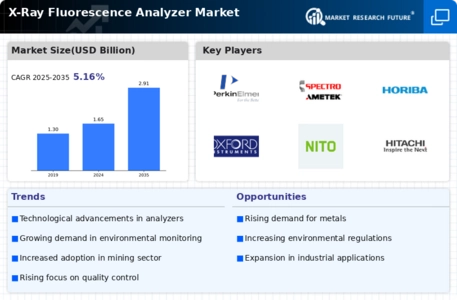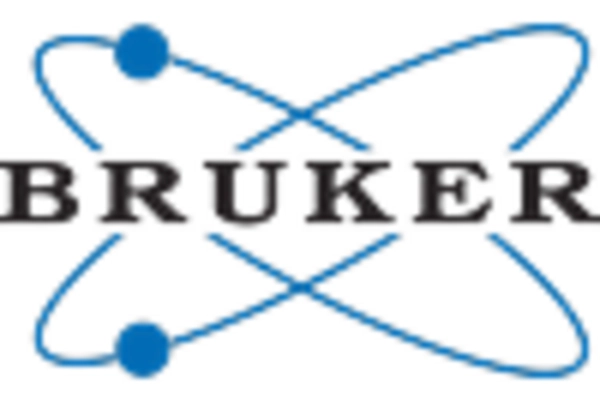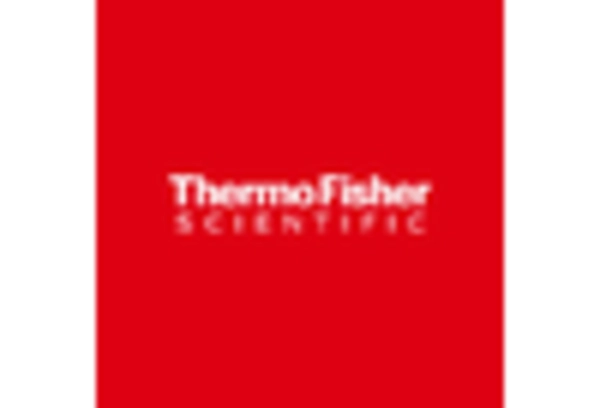Growing Demand in the Recycling Sector
The recycling industry is becoming an increasingly important driver for the X-Ray Fluorescence Analyzer Market. As the focus on sustainability and resource recovery intensifies, the need for efficient sorting and analysis of recyclable materials is paramount. XRF analyzers enable recyclers to quickly assess the composition of materials, ensuring that valuable resources are recovered while minimizing contamination. The recycling sector is projected to grow significantly, with estimates suggesting a compound annual growth rate of around 7% in the coming years. This growth is likely to propel the demand for XRF technology, as recyclers seek to optimize their processes and improve material recovery rates. Consequently, the X-Ray Fluorescence Analyzer Market is poised for expansion as it aligns with the sustainability goals of various industries.
Regulatory Compliance and Quality Control
In various industries, stringent regulations regarding material composition and safety standards are becoming increasingly prevalent. The X-Ray Fluorescence Analyzer Market is significantly influenced by the need for compliance with these regulations. Industries such as construction, electronics, and food safety are mandated to ensure that their products meet specific elemental composition standards. XRF analyzers facilitate this compliance by providing accurate and rapid analysis of materials, thus reducing the risk of non-compliance penalties. The market for XRF analyzers is expected to grow as companies prioritize quality control measures to adhere to these regulations. It is estimated that the demand for XRF technology in regulatory compliance applications could account for a substantial portion of the market share in the coming years.
Rising Adoption in Environmental Monitoring
The X-Ray Fluorescence Analyzer Market is witnessing increased adoption in environmental monitoring applications. As concerns regarding pollution and environmental degradation rise, there is a growing need for accurate monitoring of hazardous materials in soil, water, and air. XRF analyzers provide a rapid and effective means of detecting heavy metals and other contaminants, making them essential tools for environmental agencies and research institutions. The market for environmental monitoring is projected to expand, with XRF technology playing a crucial role in ensuring compliance with environmental regulations. This trend indicates that the X-Ray Fluorescence Analyzer Market will likely see a significant increase in demand as environmental awareness continues to grow.
Increasing Demand in Mining and Metal Industries
The X-Ray Fluorescence Analyzer Market is experiencing a surge in demand, particularly from the mining and metal sectors. These industries require precise elemental analysis for quality control and compliance with regulatory standards. The ability of XRF analyzers to provide rapid, non-destructive testing makes them invaluable in assessing ore grades and metal content. As mining operations expand, the need for efficient and accurate analysis tools is likely to grow. Reports indicate that the mining sector is projected to witness a compound annual growth rate of approximately 5% over the next few years, further driving the adoption of XRF technology. This trend suggests that the X-Ray Fluorescence Analyzer Market will continue to thrive as companies seek to enhance operational efficiency and product quality.
Technological Innovations and Product Development
Technological advancements are a key driver in the X-Ray Fluorescence Analyzer Market. Continuous innovations in XRF technology, such as improved sensitivity, portability, and data analysis capabilities, are enhancing the functionality of these analyzers. Manufacturers are investing in research and development to create more sophisticated models that cater to diverse applications, from industrial to laboratory settings. The introduction of portable XRF analyzers has opened new avenues for on-site testing, which is particularly beneficial in remote locations. As technology evolves, the market is expected to expand, with new product launches likely to attract a broader customer base. This trend suggests that the X-Ray Fluorescence Analyzer Market will remain dynamic and competitive.

















Leave a Comment